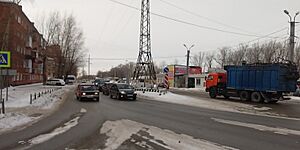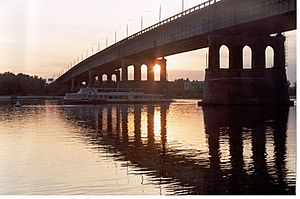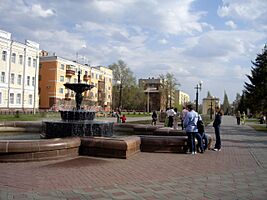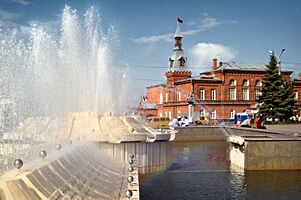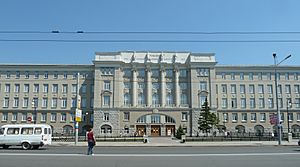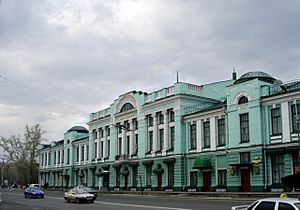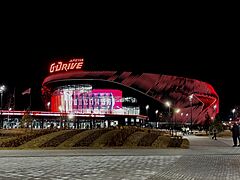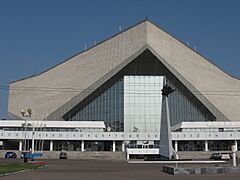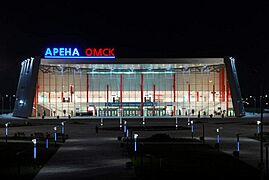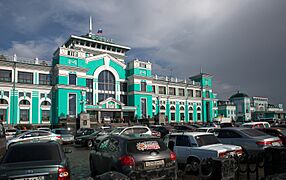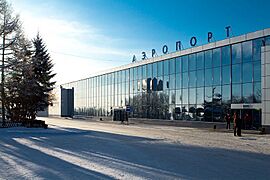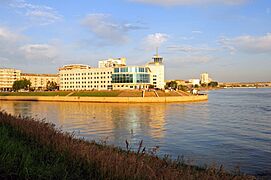Omsk facts for kids
Quick facts for kids Omsk (English)Омск (Russian) |
|
|---|---|
| - City - | |
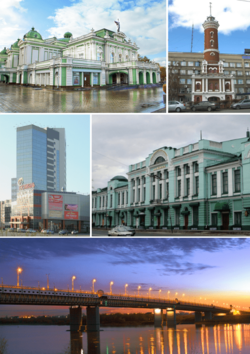 Top: Omsk State Academic Drama Theater, Fire Observation Tower, (left to right) Middle: Omsk Festiwal Complex Center area, Vrubel Fine Art Museum, (left to right) Bottom: 60 years Victory Bridge (Most 60 Letiya Pobedy) |
|
|
|
|
| City Day | First Saturday of August |
| Administrative status | |
| Country | Russia |
| Federal subject | Omsk Oblast |
| Administratively subordinated to | city of oblast significance of Omsk |
| Municipal status | |
| Urban okrug | Omsk Urban Okrug |
| Mayor | Sergey Shelest |
| Representative body | City Council |
| Statistics | |
| Area | 572.9 km2 (221.2 sq mi) |
| Population (2010 Census, preliminary) |
1,154,116 inhabitants |
| - Rank in 2010 | 7th |
| Density | 2,015/km2 (5,219/sq mi) |
| Time zone | OMST (UTC+07:00) |
| Founded | August 2, 1716 |
| City status since | 1782 |
| Postal code(s) | 644xxx |
| Dialing code(s) | +7 3812 |
| Official website: http://www.admomsk.ru | |
Omsk is a large city in Russia, located in southwestern Siberia. It is the main city and administrative center of Omsk Oblast. With over 1.1 million people, Omsk is the third largest city in Siberia. Only Novosibirsk and Krasnoyarsk are bigger. It is also the twelfth-largest city in all of Russia.
Omsk is a very important place for travel. It has a train station on the famous Trans-Siberian Railway. It is also a key stop on the Irtysh River, where boats can travel.
Long ago, during the time of the Russian Empire, Omsk was an important government center. For a short time during the Russian Civil War (1918–1920), it was even the capital of an anti-Bolshevik government. The city also held the country's gold reserves. Today, Omsk is a religious center for both Christian and Muslim leaders in Siberia. The current mayor is Sergey Shelest.
Contents
- Etymology: What's in a Name?
- History: A Look Back in Time
- Geography: Where Omsk Is Located
- Demographics: Who Lives in Omsk?
- Architecture: Buildings and Landmarks
- Education: Learning in Omsk
- Culture: Arts and Entertainment
- Economy: How Omsk Works
- Honors: Named After Omsk
- Notable People: Famous Faces from Omsk
- Twin Towns: Omsk's Sister Cities
- See also
Etymology: What's in a Name?
The city of Omsk gets its name from the Om river. In the local language of the Baraba Tatars, the word "Om" means "the quiet one."
History: A Look Back in Time
Historical affiliations
![]() Tsardom of Russia, 1716–1721
Tsardom of Russia, 1716–1721
![]() Russian Empire, 1721–1917
Russian Empire, 1721–1917
![]() Russian Republic, 1917–1918
Russian Republic, 1917–1918
![]() Provisional All-Russian Government, 1918–1919
Provisional All-Russian Government, 1918–1919
![]() Soviet Union (RSFSR), 1919–1991
Soviet Union (RSFSR), 1919–1991
![]() Russia, 1991–present
Russia, 1991–present
Building the Omsk Fortress
In the early 1700s, Russia wanted to make trade routes to China safer. Prince M.P. Gagarin, the Siberian governor, saw the need for strong forts along the Irtysh River. These forts would protect traders from attacks by groups like the Kalmyks and Kirghiz-Kaisaks.
In 1714, the Tsar agreed to build these forts. An expedition led by Ivan Bukholts was sent to build them. On August 2, 1716, the first Omsk fortress was built at the point where the Om River flows into the Irtysh River. It was a simple fort made of earth, with storage for gunpowder and food, and barracks for soldiers.
However, this first fort was not very strong. Its defenses were spread out, making it hard to defend. So, in 1717, a new, stronger fortress was planned. This second Omsk fortress was built on the right bank of the Om River. It was designed to be more secure.
Omsk Becomes a City
In 1768, the Omsk fortress was moved to a new location. Some parts of the old fortress, like the Tobolsk and Tara gates, and a German Lutheran Church, can still be seen today. Omsk officially became a town in 1782.
By 1822, Omsk grew even more important. It became the administrative capital of Western Siberia. Later, in 1882, it became the center of a large region called the Steppes. During this time, many churches, mosques, a synagogue, and a military academy were built.
Omsk also became a place where people who were exiled (sent away from their homes as punishment) were sent. The famous writer Fyodor Dostoyevsky was imprisoned in Omsk from 1850 to 1854. The old Omsk fortress was eventually taken down in 1864 because it was no longer needed for military defense.
Growth and Change
The city really started to grow in the 1890s when the Trans-Siberian Railway was built. This made Omsk a key place for moving goods and people. Many businesses opened stores and offices, shaping the city center. Even countries like Britain, the Netherlands, and Germany opened consulates (offices for their representatives) to help with trade.
In 1910, Omsk hosted a big event called the Siberian Exposition of Agriculture and Industry. This made the city famous and earned it the nickname "Chicago of Siberia" because of its fast growth and importance in trade.
After the October Revolution in Russia, anti-Bolshevik forces took control of Omsk in 1918. They formed a government there and made Omsk the capital of Russia for a short time. The city's central bank was in charge of keeping Russia's gold reserves safe. However, in 1919, the Red Army took over Omsk, and the government had to leave.
The Soviet Era
During the Soviet period, the government decided that Novosibirsk (then called Novonikolayevsk) would be the main city in Western Siberia. Many government, cultural, and educational activities were moved from Omsk to Novosibirsk. This slowed Omsk's growth and started a friendly rivalry between the two cities.
Omsk got a new boost during World War II. Because it was far from the fighting and had good facilities, many factories were moved there from the front lines. Omsk even had plans to become the temporary capital of the Soviet Union if Moscow fell to the Germans. After the war, Omsk remained a major industrial city, especially for military production.
In the 1950s, oil and natural gas were found in Siberia. This led to the building of a huge oil refinery complex in Omsk. A whole new area, sometimes called "town of oil workers," grew north of the city. Today, this is the largest oil refinery complex in Russia. Gazprom Neft, a big energy company, is the largest employer in Omsk.
Modern Omsk
After the dissolution of the Soviet Union in the 1990s, Omsk faced some economic challenges. Many state-owned businesses became private, leading to some struggles. However, the city also saw improvements. New parks were built, and the historic center was renovated. Omsk also started hosting the annual Siberian International Marathon and a City Days Festival.
Geography: Where Omsk Is Located
Location and Rivers
Omsk is located in the southern part of the West Siberian Plain. It sits on the banks of the Irtysh River, where the Om River joins it. The city is about 87 meters (285 ft) above sea level.
Omsk is a very important transportation hub. It's a key point on the Trans-Siberian Railway, where northern and southern train lines meet. It's also a major hub for highways in the region. The city has a river port on the Irtysh, which allows boats to travel on the Irtysh and Ob River. These waterways connect Omsk to mining towns in Kazakhstan and to oil, gas, and lumber operations in northern Siberia.
Omsk is also served by the Tsentralny Airport. This airport connects the city to other places in Russia and to international destinations, mainly in Germany and Kazakhstan. This makes Omsk an important aviation center for Siberia.
The city is about 450 km (280 mi) north of Astana, the capital of Kazakhstan. It is also about 600 km (370 mi) west of Novosibirsk, Siberia's largest city.
Climate: Seasons in Omsk
Omsk has a humid continental climate. This means it has very different seasons. Winters are long, dry, windy, and very cold. Summers are short but sunny and warm, sometimes even hot.
The average temperature in July is about +20 °C (68 °F), and in January, it's about −17 °C (1.4 °F). However, temperatures can reach +40 °C (104 °F) in summer and drop to −45 °C (−49 °F) in winter! Omsk usually gets over 300 sunny days a year. The city receives about 415 millimeters (16.3 in) of rain and snow each year.
| Climate data for Omsk (1991–2020, extremes 1875–present) | |||||||||||||
|---|---|---|---|---|---|---|---|---|---|---|---|---|---|
| Month | Jan | Feb | Mar | Apr | May | Jun | Jul | Aug | Sep | Oct | Nov | Dec | Year |
| Record high °C (°F) | 4.2 (39.6) |
8.0 (46.4) |
14.1 (57.4) |
31.3 (88.3) |
35.6 (96.1) |
40.1 (104.2) |
40.4 (104.7) |
38.0 (100.4) |
32.9 (91.2) |
27.4 (81.3) |
16.1 (61.0) |
4.5 (40.1) |
40.4 (104.7) |
| Mean daily maximum °C (°F) | −12.7 (9.1) |
−9.9 (14.2) |
−2.0 (28.4) |
10.1 (50.2) |
19.5 (67.1) |
23.8 (74.8) |
24.9 (76.8) |
22.8 (73.0) |
16.1 (61.0) |
8.3 (46.9) |
−3.4 (25.9) |
−10 (14) |
7.3 (45.1) |
| Daily mean °C (°F) | −16.9 (1.6) |
−14.6 (5.7) |
−6.6 (20.1) |
4.7 (40.5) |
13.0 (55.4) |
18.0 (64.4) |
19.4 (66.9) |
17.0 (62.6) |
10.6 (51.1) |
3.8 (38.8) |
−6.9 (19.6) |
−13.9 (7.0) |
2.3 (36.1) |
| Mean daily minimum °C (°F) | −21 (−6) |
−19 (−2) |
−11.2 (11.8) |
−0.2 (31.6) |
6.6 (43.9) |
12.1 (53.8) |
14.0 (57.2) |
11.7 (53.1) |
5.7 (42.3) |
−0.1 (31.8) |
−10 (14) |
−17.8 (0.0) |
−2.4 (27.7) |
| Record low °C (°F) | −45.1 (−49.2) |
−45.5 (−49.9) |
−41.1 (−42.0) |
−26.4 (−15.5) |
−12.9 (8.8) |
−3.1 (26.4) |
2.1 (35.8) |
−1.7 (28.9) |
−7.6 (18.3) |
−28.1 (−18.6) |
−41.2 (−42.2) |
−44.7 (−48.5) |
−45.5 (−49.9) |
| Average precipitation mm (inches) | 21 (0.8) |
18 (0.7) |
19 (0.7) |
26 (1.0) |
31 (1.2) |
55 (2.2) |
65 (2.6) |
56 (2.2) |
30 (1.2) |
33 (1.3) |
35 (1.4) |
29 (1.1) |
418 (16.5) |
| Average extreme snow depth cm (inches) | 33 (13) |
41 (16) |
39 (15) |
5 (2.0) |
0 (0) |
0 (0) |
0 (0) |
0 (0) |
0 (0) |
1 (0.4) |
8 (3.1) |
22 (8.7) |
149 (59) |
| Average rainy days | 1 | 0.4 | 3 | 10 | 17 | 17 | 18 | 19 | 18 | 13 | 5 | 1 | 122 |
| Average snowy days | 28 | 25 | 18 | 9 | 2 | 0.2 | 0 | 0 | 1 | 11 | 22 | 28 | 144 |
| Average relative humidity (%) | 80 | 78 | 75 | 63 | 52 | 61 | 68 | 70 | 70 | 73 | 81 | 82 | 71 |
| Mean monthly sunshine hours | 83.9 | 129.6 | 200.6 | 237.5 | 306.9 | 317.1 | 297.0 | 257.1 | 177.7 | 121.1 | 71.8 | 54.8 | 2,255.1 |
| Source 1: Pogoda.ru.net | |||||||||||||
| Source 2: NOAA | |||||||||||||
Demographics: Who Lives in Omsk?
| Historical population | ||
|---|---|---|
| Year | Pop. | ±% |
| 1897 | 37,400 | — |
| 1926 | 157,906 | +322.2% |
| 1939 | 288,855 | +82.9% |
| 1959 | 581,108 | +101.2% |
| 1970 | 821,151 | +41.3% |
| 1979 | 1,014,246 | +23.5% |
| 1989 | 1,148,418 | +13.2% |
| 2002 | 1,134,016 | −1.3% |
| 2010 | 1,154,116 | +1.8% |
| 2021 | 1,125,695 | −2.5% |
| Source: Census data | ||
The number of people living in Omsk has changed over time. In 1881, there were about 31,000 people. By 1989, the population grew to over 1.1 million. In 2010, it was 1,154,116 people. By 2021, the population was 1,125,695.
Most people in Omsk are Russians. Other groups living in the city include Kazakhs, Tatars, Ukrainians, and Germans.
Architecture: Buildings and Landmarks
The heart of Omsk's architecture is along Lyubinsky Avenue/Lenina Street. Here you can see many different building styles, including Art Nouveau and Neoclassical.
Near where the Om and Irtysh rivers meet, you can find a few old buildings from the 18th-century fortress. The biggest and most beautiful church in Omsk is the Dormition Cathedral. It has five domes and was first built in 1896. It was later rebuilt in the early 2000s.
Another interesting area is Nikolsky Avenue-Krasnykh Zor Street. Here, you can still see old wooden houses that belonged to merchants. This street leads to the Neoclassical Cathedral of St. Nicholas. It was built for the Cossacks and finished in 1840. Inside, it holds important items from the Siberian Cossacks.
The Achair Women's Monastery is also an important place to see. It is known for a warm mineral spring on its grounds. Many believe this spring has healing properties.
Education: Learning in Omsk
Omsk is a big center for learning. It has many colleges and universities where students can study different subjects. Some of these include:
- Omsk State Medical University
- Omsk State Transport University (since 1961)
- Omsk State Agrarian University (since 1918)
- Omsk State Pedagogical University
- Omsk State University (since 1974)
- Omsk State Technical University (since 1942)
- Siberian State Automobile and Highway Academy (SibADI)
- Siberian Academy of Physical Culture (SibGUFK)
Culture: Arts and Entertainment
As a major educational city, Omsk offers many cultural experiences. It has several museums, theaters, and music places.
Some of the notable museums are:
- The State Museum of Regional History
- The Dostoyevsky Museum of Literature
- The Vrubel Museum of Fine Arts
- The Military Museum Complex
Theaters in Omsk include the Omsk Opera, The Omsk Theater of Drama, The Omsk Circus, and the Omsk State Music Theater.
Sports: Teams and Arenas
Omsk is home to several professional sports teams, especially in ice hockey and football.
| Club | Sport | Founded | Current league | League rank |
Stadium |
|---|---|---|---|---|---|
| Avangard Omsk | Ice Hockey | 1950 | Kontinental Hockey League | 1st | G-Drive Arena |
| Omsk Hawks | Ice Hockey | 2009 | MHL | Hockey Academy Avangard | |
| Omskie Yastreby | Ice Hockey | 2009 | Minor Hockey League | Jr. 1st | G-Drive Arena |
| Yastreby Omsk | Ice Hockey | 2012 | Minor Hockey League Division B | Jr. 2nd | G-Drive Arena |
| Omichka Omsk | Volleyball | 1965 | Woman's Volleyball Super League | 1st | Blinov SCC |
| Omichka-2 | Volleyball | 2009 | Woman's Supreme League | 2nd | SC Ermak |
| Irtysh Omsk | Football | 1946 | Russian Second Division | 2nd | Red Star Stadium |
| Neftyanik Omsk | Basketball | 1965 | Basketball Superleague B | 3rd | Sports Complex Sibirskiy Neftyanik |
Economy: How Omsk Works
Gazprom's Omsk Refinery is the biggest employer in the city. This large oil refinery processes oil and gas.
Omsk also has a history of military production. The Russian Air Force has a base nearby called Omsk-Severnyy (air base). Factories like the OKMO tank-design bureau and Omsk Transmash have produced military vehicles, including T-80 tanks.
Transportation: Getting Around Omsk
Omsk is a major hub for trains, roads, and air travel. The city has a station on the famous Trans-Siberian Railway. The Tsentralny Airport serves Omsk for air travel.
Omsk also has a river port on the Irtysh River. This port connects the city to other places in Russia and Kazakhstan by water. The city is part of European route E30 (which is the R254 highway in Russia), linking it to other parts of Europe.
For getting around the city, Omsk has buses and trolleys. There are also Marshrutkas, which are like shared taxis. A Metro system (subway) is being built. One part of the Metro bridge over the Irtysh River is already open for cars on the upper level, but the subway part on the lower level is still under construction.
Honors: Named After Omsk
- The 3406 Omsk asteroid, a small rocky body in space, is named after the city.
Notable People: Famous Faces from Omsk
- Innokenty Annensky, poet
- Nina Arkhipova, actress
- Vladislav Artemiev, chess grandmaster
- Fyodor Dostoyevsky, writer and essayist, lived here in exile
- Vladislav Dvorzhetsky, actor
- Eva Elfie, actress
- Alexander Ivanov, chess grandmaster
- Wacław Iwaszkiewicz-Rudoszański, Polish general
- Eduard Kunz, pianist
- Dmitry Karbyshev, general
- Vilis Krištopans, former Prime Minister of Latvia
- Valerian Kuybyshev, revolutionary
- Sergey Letov, jazz musician
- Yegor Letov, rock musician
- Vladimir Lukin, politician
- Leonid Martynov, poet
- Lyubov Polishchuk, actress
- Grigory Potanin, ethnographer and natural historian
- Ludmilla Radchenko, model and actress
- Vlada Roslyakova, model
- Robert Rozhdestvensky, poet
- Vissarion Shebalin, composer
- Mikhail Shivlyakov, marine, strongman
- Valentina Talyzina, actress
- Tamāra Vilerte, Latvian chess player
- Mikhail Vrubel, artist
- Mikhail Ulyanov, actor
- Nikolai Yadrintsev, explorer and archaeologist
- Dmitry Yazov, Russian general
- Keyyo, Swedish comedian
Athletes from Omsk
- Egor Averin, ice hockey player
- Vladimir Barnashov, biathlete and biathlon coach
- Vitalina Batsarashkina, sports shooter
- Vera Biryukova, rhythmic gymnast
- Viktor Blinov, ice hockey player
- Tatiana Borodulina, speed skater
- Yegor Chinakhov, ice hockey player
- Ksenia Dudkina, rhythmic gymnast
- Dmitrij Jaskin, ice hockey player
- Sergei Kalinin, ice hockey player
- Yevgeniya Kanayeva, rhythmic gymnast, first and only twice olympic champion at individual rhythmic gymnastics competition
- Yuliya Kosenkova, middle-distance athlete
- Vera Krasnova, speed skater
- Ilya Mikheyev, ice hockey player
- Marat Mulashev, professional football
- Nikita Nikitin, ice hockey player
- Nikita Pivtsakin, ice hockey player
- Anastasija Reiberger, pole vaulter
- Dennis Siver, mixed martial arts fighter
- Yuri Shatalov, ice hockey player
- Alexander Shlemenko, mixed martial arts fighter
- Galima Shugurova, rhythmic gymnast
- Sofya Skomorokh, rhythmic gymnast
- Roman Sloudnov, swimmer
- Alexander Svitov, ice hockey player
- Dmitri Sychev, association football player
- Andrei Taratukhin, ice hockey player
- Irina Tchachina, rhythmic gymnast
- Aleksei Tishchenko, boxer
- Polina Tsurskaya, figure skater
Twin Towns: Omsk's Sister Cities
Omsk has special friendships with other cities around the world, called "twin towns" or "sister cities." These connections help promote cultural exchange and understanding.
See also
 In Spanish: Omsk para niños
In Spanish: Omsk para niños



